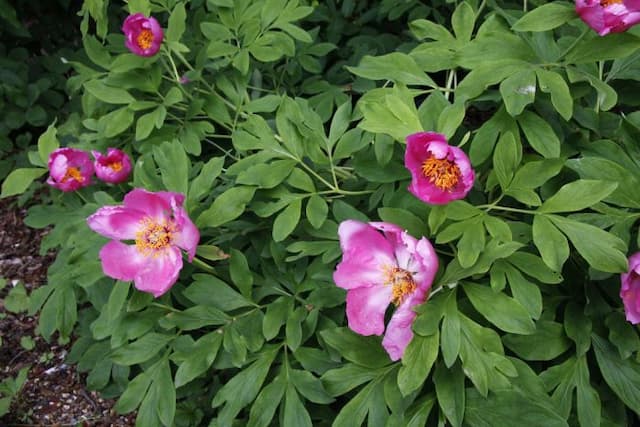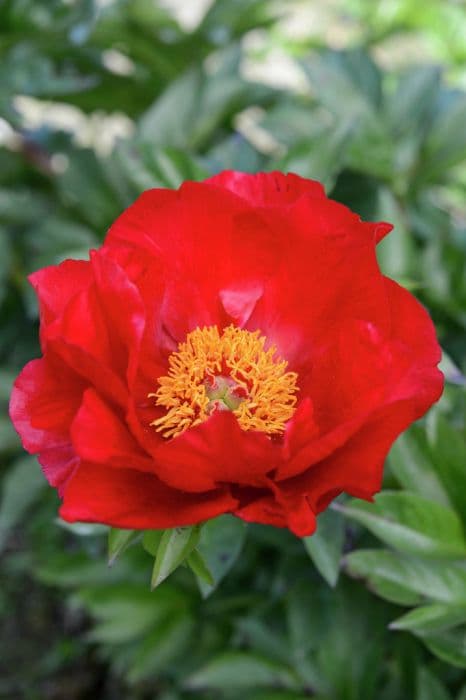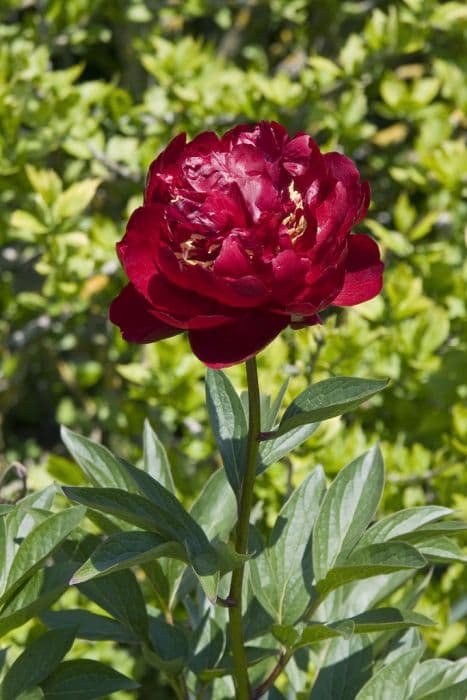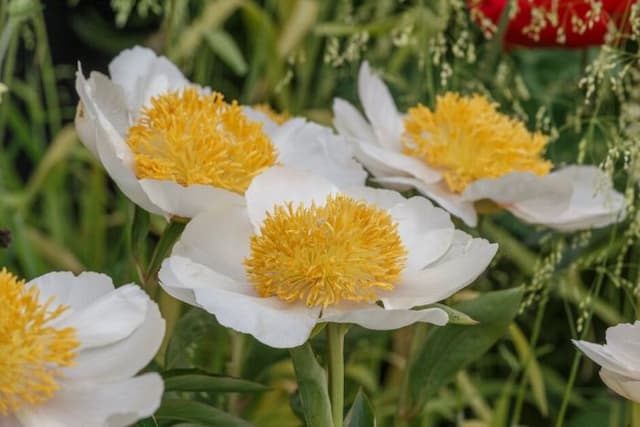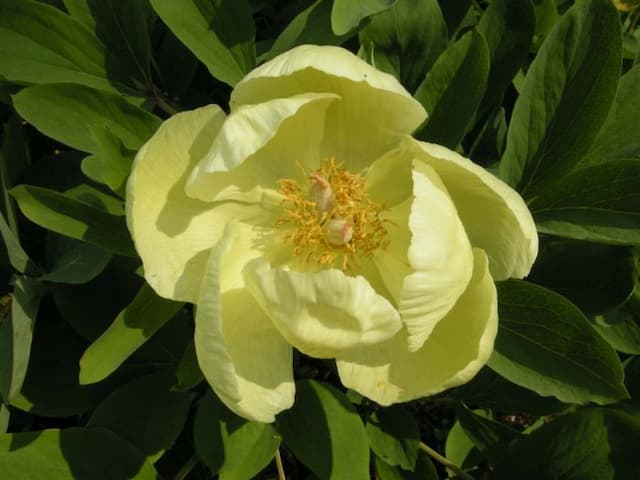Chinese Peony Paeonia lactiflora 'Chippewa'

ABOUT
The Paeonia lactiflora 'Chippewa', commonly known as the Chinese peony, is a perennial plant renowned for its large, showy flowers. These blossoms are a striking feature, typically showcasing a deep pink hue that can range from soft to more intense shades. The outer petals are broad and often slightly ruffled, encircling a center packed with smaller, fluffy petals or staminodes that may be slightly lighter in color, sometimes even appearing with a silvery sheen. At the heart of the bloom, contrasting yellow stamens may be visible, offering a beautiful contrast that highlights the lushness of the flower. The foliage of the Chinese peony 'Chippewa' consists of lush green leaves that provide an attractive backdrop to the flowers. These leaves are typically glossy and deeply lobed, with a shape that can be described as lanceolate to ovate, coming to a pointed tip. The plant tends to have an upright, bushy habit, producing a generous amount of blooms during its flowering period. The blossoms emit a pleasant fragrance that is often described as subtly sweet. Overall, the 'Chippewa' peony is a charming and elegant plant that can add a touch of romance and old-world beauty to any garden setting.
About this plant
 Names
NamesFamily
Paeoniaceae.
Synonyms
Chinese Peony, White Peony, Common Garden Peony.
Common names
Paeonia lactiflora.
 Toxicity
ToxicityTo humans
The most common name for Paeonia lactiflora 'Chippewa' is Peony. Peonies are generally not considered toxic to humans. However, as with many plants, it is possible that some individuals might experience mild stomach upset if they ingest peony parts. While these flowers are not typically considered dangerous, it is advisable to avoid eating them and to keep them out of reach of children who might be tempted to chew on them.
To pets
The common name for Paeonia lactiflora 'Chippewa' is also Peony. Peonies are considered to be low-toxicity plants for pets such as cats and dogs. If a pet ingests a large amount of a peony plant, they might experience mild gastrointestinal upset, including symptoms such as diarrhea or vomiting. While not highly poisonous, it is best to prevent pets from consuming this plant to avoid any potential discomfort.
 Characteristics
CharacteristicsLife cycle
Perennials
Foliage type
Deciduous
Color of leaves
Green
Flower color
Pink
Height
2-3 feet (60-90 cm)
Spread
2-3 feet (60-90 cm)
Plant type
Herb
Hardiness zones
3-8
Native area
Asia
Benefits
 General Benefits
General Benefits- Ornamental Value: The Chinese peony, with its large, showy flowers, acts as an eye-catching addition to gardens and landscapes.
- Variety of Colors: It offers a range of colors that can complement different garden designs and color schemes.
- Fragrance: Its blooms emit a pleasant fragrance that can enhance the sensory experience of a garden.
- Longevity: Chinese peonies are known for their long lifespan, with some plants living for over 100 years with proper care.
- Seasonal Interest: They provide spring to early summer interest before many other plants have started to bloom.
- Cut Flowers: The blooms are excellent for cutting and can create elegant floral arrangements.
- Attracts Pollinators: They attract bees and other beneficial insects, contributing to the health of the garden ecosystem.
- Low Maintenance: Once established, Chinese peonies require relatively little maintenance, making them suitable for many gardeners.
- Cold Hardy: These plants are capable of withstanding cold winters, making them suitable for cooler climates.
- Drought Tolerance: They can survive periods of low water availability after they are established.
 Medical Properties
Medical Properties- Anti-inflammatory: Peony root, including that of Paeonia lactiflora, has been traditionally used to reduce inflammation.
- Immunomodulatory: Compounds in Paeonia lactiflora may have effects on the immune system, potentially modifying immune responses.
- Antioxidant: The root of Paeonia lactiflora contains antioxidants, which may help protect cells from damage by free radicals.
- Anxiolytic: There is some evidence to suggest that Paeonia lactiflora may have a mild sedative effect, helping to reduce anxiety.
- Analgesic: Peony preparations have been used in traditional medicine to alleviate pain.
 Air-purifying Qualities
Air-purifying QualitiesThis plant is not specifically known for air purifying qualities.
 Other Uses
Other Uses- Paeonia lactiflora 'Chippewa', commonly known as Chinese peony, can be used in floral art arrangements due to its large, attractive blossoms which provide an elegant and focal point in any floral composition.
- The petals of the Chinese peony can be used to create natural dyes for fabric, providing a soft pink to purple hue, depending on the preparation and fabric type.
- The sturdy stems of the Chinese peony can be used in lightweight garden structures, such as pea trellises or for supporting other plants that require a little help staying upright.
- Chinese peony's dense foliage can offer a natural privacy screen in gardens when planted in a row or as part of a mixed border.
- The spent blooms of Chinese peony can be composted to add nutrients back into the soil, promoting a healthier garden ecosystem.
- Chinese peony can be used in cut flower gardens, as their long vase life makes them ideal for indoor decoration long after being removed from the plant.
- Pressed flowers of the Chinese peony can be used in crafting, like creating bookmarks, greeting cards, or in decoupage projects, due to their vibrant color and texture.
- During off-blooming seasons, the dried seed pods of Chinese peony can be utilized in dried flower arrangements or as a distinct element in wreaths and other dry crafts.
- Chinese peony plants may act as a natural shelter for beneficial insects in the garden, including bees during their blooming period and ladybugs that help control pest populations.
- The large leaves of Chinese peony can be used as a natural mulch, as they decompose to create an organic layer that retains moisture and suppresses weeds.
Interesting Facts
 Feng Shui
Feng ShuiThe common Peony is not used in Feng Shui practice.
 Plant Symbolism
Plant Symbolism- Honor and Wealth: Paeonia lactiflora, commonly known as Peony, often symbolizes wealth and honor. Their lush, full blooms are associated with opulence and the idea of being honored or esteemed in society.
- Romance and Love: Peonies are also a popular symbol of love and romance. They are commonly used in wedding bouquets and decorations to represent a happy marriage and the romantic bliss between couples.
- Beauty: The striking beauty of the Peony flower has made it a symbol of aesthetic appeal and charm, often used to denote physical attractiveness and allure.
- Prosperity and Good Luck: In certain cultures, particularly in China and Japan, Peonies are believed to bring good fortune and success, making them a favorite for festive occasions.
 Water
WaterFor the common Peony, watering should be thorough and infrequent to encourage deep root growth. It's ideal to water these plants once a week with about 1 inch (0.625 gallons) of water, especially during dry spells. During the growing season, if there has been rain, additional watering might not be necessary. However, once the buds begin to form and until after they bloom, it's vital to ensure the soil remains evenly moist. Always avoid overhead watering to keep the foliage dry, thereby reducing the risk of disease.
 Light
LightPeonies thrive best in full sun locations, receiving at least 6 to 8 hours of sunlight daily. The ideal spot for a Peony is an area where it can enjoy uninterrupted morning light and some protection from the intense afternoon sun, especially in hotter climates.
 Temperature
TemperaturePeonies prefer temperate climates and are hardy in a range of conditions, but they grow best when summer temperatures average around 65°F to 75°F. They can tolerate winter chill down to about -20°F and need a period of winter cold, preferably below 40°F, to flower successfully.
 Pruning
PruningPrune Peonies in the fall to remove dead leaves and stems, this helps to prevent disease and keeps the plant looking tidy. Cut back the foliage to the ground after the first frost. Pruning in the fall also helps the plant to conserve energy for the next season's growth.
 Cleaning
CleaningAs needed
 Soil
SoilThe common peony thrives in well-drained, loamy soil enriched with compost or aged manure. A pH range of 6.5 to 7.5 is ideal for optimal growth and blooming.
 Repotting
RepottingPeonies, including the common peony, rarely need repotting and do best when left undisturbed. They may be divided or transplanted in fall if necessary.
 Humidity & Misting
Humidity & MistingCommon peonies are adaptable to a wide range of humidity levels and do not require specific humidity conditions to thrive.
 Suitable locations
Suitable locationsIndoor
Not ideal indoors; requires deep planting, cool temps, direct light.
Outdoor
Plant in sunny area; ensure rich, well-draining soil.
Hardiness zone
3-8 USDA.
 Life cycle
Life cyclePaeonia lactiflora 'Chippewa', commonly known as Chinese peony, begins its life cycle as a dormant tuberous root, typically planted in the fall. In early spring, the plant breaks dormancy, and red shoots emerge, quickly turning green as leaves develop. Throughout late spring, the peony grows steadily, producing lush foliage and eventually buds that burst into large, scented flowers, often in late spring to early summer, depending on the climate. After blooming, the plant sets seed in the form of a capsule if pollination occurs, although many gardeners remove spent blooms to encourage root growth. During the summer months, the foliage provides ongoing visual interest and photosynthesis for the next year's growth. As autumn approaches, the plant's leaves begin to yellow and die back as it enters dormancy, storing energy in its roots for the next growing season.
 Propogation
PropogationPropogation time
Early Spring
The common peony, specifically Paeonia lactiflora 'Chippewa', is usually propagated by division. This process is best done in the fall when the plant has gone dormant after flowering and the leaves have died back. To propagate by division, carefully dig up the entire peony clump, then gently shake off the excess soil. Using a sharp knife, divide the clump into sections ensuring each section has at least 3-5 buds, also called "eyes," which are the small reddish growths on the crown of the root. These divisions can then be replanted in well-draining soil with the buds positioned no more than 2 inches (approximately 5 centimeters) below the soil surface, as planting too deep can prevent flowering. Water the newly planted divisions thoroughly and wait for the growth to emerge in the following spring.
